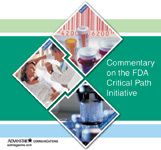Critical Path—Build It Collaboratively or Collectively?
Applied Clinical Trials
When the FDA stated that "the applied sciences needed for medical product development have not kept pace with the tremendous advances in the basic sciences" everyone seemed to agree.
When the FDA stated that "the applied sciences needed for medical product development have not kept pace with the tremendous advances in the basic sciences" everyone seemed to agree. This premise lead to the formation of the Critical Path Initiative. Unfortunately "the Path" analogy may wrongfully suggest that the way to an approvable product will be long and winding, as opposed to a science-navigated short-cut.

Pieter Muntendam, MD
Presently, tools exist to carefully study what drugs do at the molecular level, but we are hostage to decade-old guidelines that tell us to monitor patients with routine chemistry and subjective scores. How do we reengineer drug development using the tools from the last decade to open the black box of drug effects?
In the 1990s information technology became available to transform the way people and corporations communicated. Contrary to the above Critical Path statement, application kept pace with the emerging technology, and these applications often drove technology advances.
There was no blueprint for building the information superhighway with its entry ramps from almost every corporation, home or cell phone. However, even in this unplanned Internet building frenzy, there were enabling-structured collaborative partnerships, without which the Internet would not have been able to deliver on its promise. An example of such collaborative effort was the work of the Mortgage Industry Standards Maintenance Organization. These standards enabled standardized exchanges of mortgage-related information between parties involved in a mortgage transaction, which resulted in rapid, low-cost processing of applications. This resulted in low-cost refinancing, which played a key role in maintaining our economy after the 2000 collapse of the stock market.
This appears to be an attractive model to change the drug development paradigm—primarily unplanned collective and collaborative where this makes sense.
Internal versus regulatory focus
Although the FDA's Critical Path focus relates to the regulatory assessment of safety and efficacy, the bigger opportunity is around the internal drug discovery and development process. Opening the" black box" will allow companies to develop compounds more quickly and with increased safety and efficacy even if the regulatory stretch remains an unpaved bumpy stretch on the road to approval.
For example, a biomarker of antidepressant effect can be used for candidate selection, dose-response, and to predict efficacy on the basis of short, small studies. This would have immense value even if the confirmatory studies required for approval would not change. Likewise, proteomic and metabolomic fingerprinting of an experimental Cox-2 can tell us whether the new drug looks like Vioxx, Celebrex or neither.

Most preclinical models tell us what compounds are toxic for mouse, rat or dog. Few compounds that have showed preclinical toxicity ever have made it into man. Of those that did, some proved the animal model wrong. Unfortunately, many compounds that cleared the preclinical hurdles were later found to have toxic effects. Finding improved preclinical safety tests is undoubtedly the sweet spot for structured collaboration.
Hepatic toxicity is the most common preclinical and clinical toxicity leading to suspension of development of the compound. Available cross-omic platforms allow for rapid characterization of drug-induced states—it can tell us what happens at the cellular level and what circulating markers can be used to monitor these cellular effects when we do not have access to the tissue.
Industry-led hepatotoxicity collaborative effort
Several of our global pharmaceutical partners have expressed an interest in participating in a cross-omics ("systems") hepatotoxicity project. We are now in the design and planning stage of a nimble, phased collaborative project on clinical hepatotoxicity. The most likely focus will be drugs that were found to increase ALT in a subset of patients in clinical trials. The objective is to characterize the molecular hepatic effects in rats of 5–10 drugs that in man may give rise to these ALT elevations. This would answer the question whether drugs ALT elevations in man share a common fingerprint, and if not, how many different types of fingerprints exists and what the circulating markers of these would be.
The first possible benefit would be the discovery of preclinical biomarkers in rodents of subsequent ALT elevations in man, and the differentiation between inconsequential ALT elevations and ALT elevations from hepatocyte damage. Participating companies would get access to all data and right to develop and use the biomarkers.
Individual efforts and nimble collaborative projects like these should pave the way to improved drug development—providing benefits to patients, payors, and pharma companies alike.

FDA Fast Tracks Johnson & Johnson’s Nipocalimab for Fetal Neonatal Alloimmune Thrombocytopenia
March 27th 2024Johnson & Johnson is moving forward with a pair of Phase III trials of nipocalimab to reduce the risk of fetal neonatal alloimmune thrombocytopenia in alloimmunized pregnant patients.